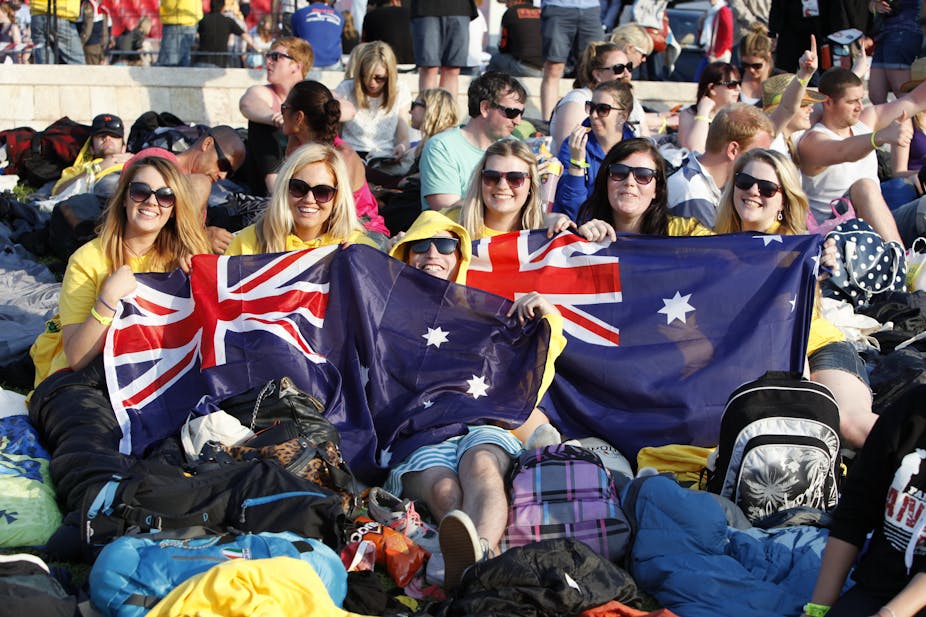Thousands of young Australians will gather at Gallipoli this Anzac Day. Our TV screens will fill with faces in the cold light of early dawn, a tear trickling down the cheek in sadness that so many died so young. Around Australia, descendants of veterans will attend marches and wear the family’s medals with pride.
But when I was a teenager in the 1980s, I would not have been seen dead wrapped in an Australian flag on Anzac Day. My friends and I never talked about including a trip to Gallipoli on a backpacking holiday.
So what has changed between the 1980s and 2014? Why has Anzac experienced such a resurgence? The tears at dawn services provide a clue. Anzac’s continuing power in the 21st century stems from the ways in which trauma has come to sit at its very core.
Australians will better understand the current embrace of Anzac if we stop confusing it with a love of militarism. Anzac is a mythology with its origins in the exploits of men at war, but there is little talk today of weakling enemies and soldiers as exemplars of military manhood.
For example, in 2014, the Australian Defence Force collaborated with the Sydney Theatre Company to perform The Long Way Home. Professional actors and army personnel star in the play, which explores the sacrifices and challenges faced by Australian servicemen and women and their families. The play is part of the official Centenary of Anzac program, and the outgoing Chief of the Defence Force, General David Hurley, described it as:
…deeply emotive and a powerful reminder of the trauma of war.
For narratives to survive and thrive, they must speak to deeply held concerns and obsessions of the culture. Trauma is one of them.
The rise of PTSD
The changed attitude towards Anzac, which began in the 1980s, was exactly coincident with new understandings of trauma and victimhood. In 1980, post-traumatic stress disorder (PTSD) was first classified as a psychiatric condition. As a consequence, victims gained new cultural status and legitimacy.
PTSD effectively revolutionised the way war neurosis, and trauma more generally, was understood. Previously, most psychiatry considered that combat exacerbated a pre-existing mental condition or weakness in neurosis cases. With the introduction of PTSD, the event itself was considered the trigger, making any healthy person vulnerable to its impact.
Cultural attention began to turn to events that produced such trauma. War was a case in point. Those who survived it, the traumatised, become its new star witnesses. Vietnam veterans, reconfigured as the psychiatric casualties of a misbegotten war, began to win the sympathy that had eluded them.
The role of women
Yet in Australia it was feminists, not Vietnam veterans, who first rekindled interest in Anzac. Groups such as Women Against Rape protested at Anzac Day services in Australian cities from the late 1970s. Anzac was back on the front page in bold black letters, not because it was popular, but because it was, allegedly, being defiled.
Feminist protesters against rape in war became the unlikely bellwethers of a new era. Undoubtedly, the open discussion of sexual violence in war was an awkward intrusion of a gendered critique into this most masculine of institutions. The obscene gestures and abuse to which feminists were subject is proof enough of that.
And yet, at the same time, feminists gave new space and voice to understandings of war as a traumatising event.
In 1985, one Vietnam veteran disrupted a women’s protest on Anzac Day when he climbed aboard their float, removed his prosthesis and waved a pink plastic leg, complete with laced shoe, in the air. One newspaper commented at the time that the lost leg was “the most brilliant anti-war banner of all”.
It did not take long before the traumatised male war veteran displaced the raped woman as the leading motif of war damage. By the early 1990s, feminist protests on Anzac Day were a thing of the past.
Anzac may have shed its more militaristic overtones, but clings resolutely to its privileging of men’s suffering. The fact that a few women, usually nurses, have been admitted as “Anzac Angels” does not undermine that broader point.

Today and the future
Australians live now in a culture saturated with traumatic memories and understandings of victimhood that incite profound sympathy and give voice to those who have suffered. Think only of the stolen generations and the forgotten Australians. Their stories have changed the way Australians view history, which is more often than not seen as a wound or scar that leaves a trace on a nation’s soul.
Anzac, with its boy soldiers and its emaciated prisoners of war, is a story that resonates with the tenor of our times. It also puts the mainstream back into the picture of suffering, indeed at its very centre, at a time when competing histories have threatened to displace it.
Embracing the trauma of war has been Anzac’s salvation in terms of its reinvention for a new generation, but may well prove its Achilles’ heel. If and when we tire of watching individuals suffer, struggle and battle their demons on reality TV, which is a symptom of our culture’s obsession with trauma, Australians may well move on from the heartstrings version of Anzac that is its present incarnation.
Anzac’s appeal rests on an eagerness to hear about suffering. Because trauma can happen to anyone, we think we understand what happened to them and, in that shared sense of pain, we become one. People wrap themselves in flags and bedeck themselves with old campaign medals and feel a connection with the past.
Still, empathy is a precarious foundation for unity, and raises the possibility that by 2015 – the centenary of the first landings at Gallipoli – we might all be suffering from compassion fatigue.

